Hi!
Today marks an exciting time for us – we have officially been writing for a month! As mentioned in a previous post, I use Deedee Wills and Deanna Jump’s Writer’s Workshop units. I take a sample of their writing on the second day of school, but start our first real lesson on the first Monday of the year. I wanted to share with you some of the (in my opinion) AMAZING progress that my little writers have made over the past month!
Please note, we do Writer’s Workshop Every. Day. No matter what, we write! And I never tell them what to write during this time. All of these stories were their own choice. Very early on, we made a chart to look at if we need an idea, and I haven’t had a single child tell me they didn’t know what to write since then. Our writing time consists of some of my favourite minutes of the whole day, and my students’ as well. My class is SO excited about writing this year, and I really believe that it is because we do it every day. And I celebrate them every step of the way! They feel successful. And, guess what?! We write for TWENTY MINUTES. Every day. In a row. In kindergarten! And you could hear a pin drop, they are so focused. It IS possible, guys.
Our writing block has three parts:
1. The mini lesson. At this time, everyone is at the carpet and I model something new that I want them to try in their writing. It could be making sure my people have clothing. It could be remembering to start with a picture. It could be how to walk quietly to the word wall, pick a word that MAKES SENSE, and how to put it back when I am done. It could be how to hear sounds in words, how to use our alphabet to help us, how to add details when I think I am done, etc, etc, etc! We spend MAX 10 mins here, but it is usually more like 7. I have become a very quick drawer! I make sure that they know that I am not looking for perfection, here – I just want them to try their best :)
2. Practice. I let my students choose their paper (currently blank paper or paper with a couple lines) and they find a quiet spot and get to work. I let them work anywhere, as long as they have their own space and aren’t bothering their neighbour. Some choose to work at the table, some on the carpet, and some take bath mats (I have 6-7 in a bucket) and clip boards and work somewhere else on the floor. I put on relaxing music and the timer for 20 mins, and we work. I encourage them to try out what I showed them in the mini lesson if it works with their story.
3. Share. While my students practice, I walk around and make sure everyone is on the right path. I provide support as needed, but it is not much support (maybe a reminder to put back a word wall word, to start with a picture, or try adding some words or a label). I DO NOT spell words for my students. Not even on Day 1. And they have honestly not ever asked me to. As I walk around, I check for three students who are trying out something that I taught them. After the practice time, we all go to the carpet and sit on our work. The three students I chose plus one more (I rotate through our class list) read their stories out loud. They call on two friends for noticings or questions. Then, everyone shares their story with a partner. The share block usually takes 7-10 minutes.
On the first day, of course we didn’t write for 20 minutes!!! I forgot to take a picture of our stamina chart, but we started out with 5 minutes. And it was tricky! It is hard to stay in one spot and work if you aren’t used to it. It is hard to not run and show your teacher the great work you did. But I reminded those who needed it, and we worked hard to focus, and we got used to it. When you practice every day, it helps SO MUCH. Now our writing muscles are strong. Staying focused on our writing is second nature! It took us about 3 weeks to get to 20 minutes, but every group is different. And there is no sense in setting the timer for longer than they are able – if you can tell that you have lost them, just stop the timer and try again the next day. We had one slip up day where our stamina decreased and when I charted it, they didn’t like it ;) They worked very hard the following day to increase it again!
Here are some samples from our first day. The samples are from three students of varying academic abilities. You can see that there is little to no detail (although one sweetie did add nipples and a belly button haha!), and the only letters/words we see are one child’s name. These all show great starting points!
On the first day, I didn’t have any students write any letters or words aside from what is in their name. But that is no problem! You have to start somewhere, and I tell them to start with the words and letters that they know :)
After the first week of school, most of my students are able to identify the names of their peers. This is quick, but keep in mind – almost all of my students were already together for a year during our pre kindergarten program and were exposed to their peers’ names all the time! We only had 3 new names to learn this year. I showed them how we can add labels to people and things in our stories to help make them more clear. We also talked about how stories need to have characters and settings, and how to add details to your characters to help your readers identify who is who. In the following pictures, you will see examples of students starting to add labels (with letters or words), settings, and/or details to help us know who is who (for example, who is the tallest person in your story? Who is the smallest? What colour is everyone’s hair?).
I love teaching writing because it is automatically differentiated. I model many of the same things every day during our mini lessons. Some “get it” right away and are able to do what I show them on their own. Others are at different stages. My school board provided us with a writing continuum, which I LOVE, because I can see where my students are and what their next step should be. Take the following example :
If you look at this picture in isolation, you may think that this little sweetie has little to no clue what writing is and she hasn’t followed any of my directions or learned a thing from me. Obviously, what she has written does not make any sense (to you or me). But, you would be wrong! Check out her progress since Day 1:
Day 1 – no evidence that she understands that she is to be writing a story. She did in fact tell me that this was a kitty, but it is clear that she has some fine motor work to do (this sweetie will not be 5 until the end of December). In the second picture, we see her start to make more precise drawings, as well as a combination of the letters that she knows, and scribbles that look like they could be letters. The first picture I showed you comes next. She had discovered the word wall and copied some words (if you look closely, you can see papa, voici, as well as a few of her classmates’ names and her name), and added some symbols. When I asked her to tell me her story, the words she had written had nothing to do with it, but she is still showing that she understands that letters and words are writing, which was not at all evident on Day 1. In the last picture, you can see that she has a clear(er) picture drawn, and has attempted to label it. She gets the general idea, even though there is still little to no association between the letters that she wrote and her picture (her mommy). She is displaying a link between the photo and the “words” she wrote. For me, it is a big deal that she is able to tell her story with her voice (and didn’t just scribble and say “I don’t know” when I asked what her story was), and that she is starting to see that stories include both pictures and words. When I start individual writing conferences during our next unit, with her, we will be working on one-word labels with letters that make sense (writing the sounds she hears).
Here is some more BIG progress. At the beginning of the year, this munchkin was NOT a risk taker. For Day 1, he traced his pencil and wrote his name. That’s a great start! I make sure to congratulate everyone for trying things out, making it clear that nothing has to be perfect, as long as your try your best, and little by little, he has started taking chances. Check it out!
It is tricky to see, but in the second picture, it says “AKCL”. Arc-en-ciel! Awesome labelling. He also had already understood that he can move his labels onto the provided lines. That is where I write when I model, and he picked up on that. The third picture is from today. Today is the first day that he attempted a sentence by himself! Our lesson today was about how it is more interesting to tell a story about something that happened, or explaining why we like something, rather than just naming the parts or telling what we like. He got it! He is still working on his directionality, so his sentence starts on the second line and ends on the first, but it says “DCI FADDFLI” – “Daisy fait des follies”. You can see that he is even starting to think about spaces, and doing a SUPER job writing the sounds he hears! He can now hear most consonants and some vowels. With him during conference time, I will push him to hear more vowel sounds and to think about spacing between words (we have not talked about that as a class yet, as I only have 2-3 writers who are making sentences).
Here are a couple more sentence attempts:
 |
“Je saute dans les feuilles”. She didn’t know the letter that makes the sound /j/ or /f/ – no problem! Just skip them and write what you know :)
This little guy is a PRO at using a combination of word wall words and sounding out to make his sentences! We only have 6 words on the word wall so far, but he does a great job using them!
“Regarde une fleur jaune” and “Mme Andrea dans un igloo”. :)
With him, we will be working on spaces between words, and adding details to talk about what is happening in the story (What is Mme doing in the igloo? Why is she there?).
Here are a couple more samples of different stages along the writing continuum!
No matter what language you teach in, if you understand English, I cannot recommend Deedee Wills and Deanna Jump’s Writer’s Workshop units enough. They have completely transformed my teaching and have made my kids into proud writers. Their lessons are so easy to follow and take almost no prep, and are worth every single penny. Writing time is so precious to me. I firmly believe that our students are ALL storytellers. It is the highlight of my day to watch them grow and develop as writers, illustrators, and storytellers. I don’t believe in limiting our students’ writing by only giving them prompts to write from, or sentence shells to fill in (I like ________. Here is a ___________.). Writing from prompts is of course an important skill, but I believe that students should also be given time to write what they want – to write THEIR stories – every day. Writing should be fun! It should be exciting! It is their chance to tell me anything they want! We are limiting them when we act like they can’t write yet – show them that you believe they can, and they will! Model, model, model, and practice, practice, practice. When they are ready, they will do it too! For me, what counts at this age is their THINKING. I want them to be able to think of, and then TELL me their story, with details, using their work to support what they have to say. Then, when they are developmentally ready, the foundation has been laid and they will be able to write the creative, detailed stories that are in their brains in a way that will allow everyone else to enjoy them, too!
Happy writing! :)


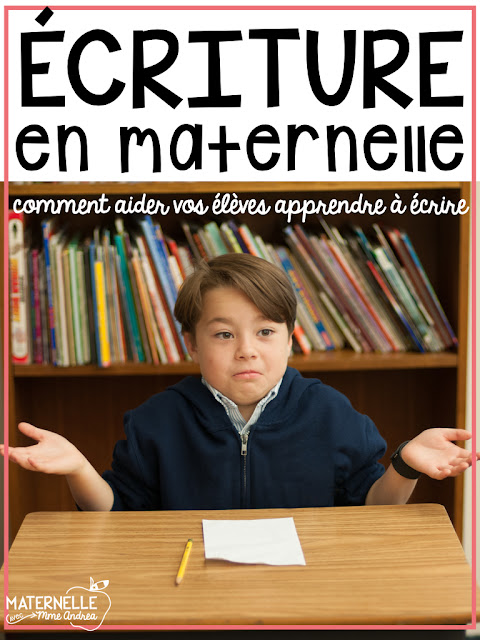
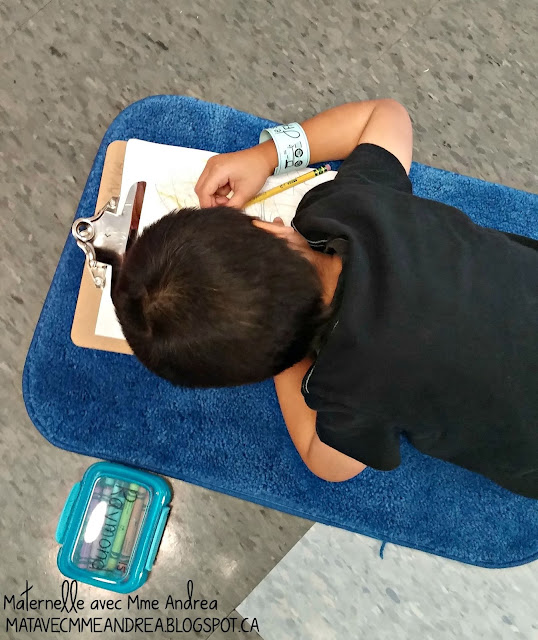


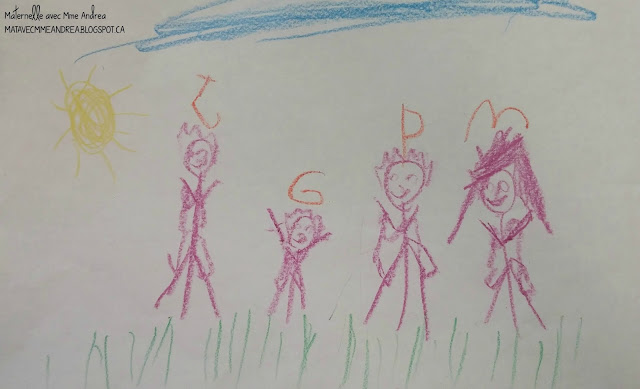
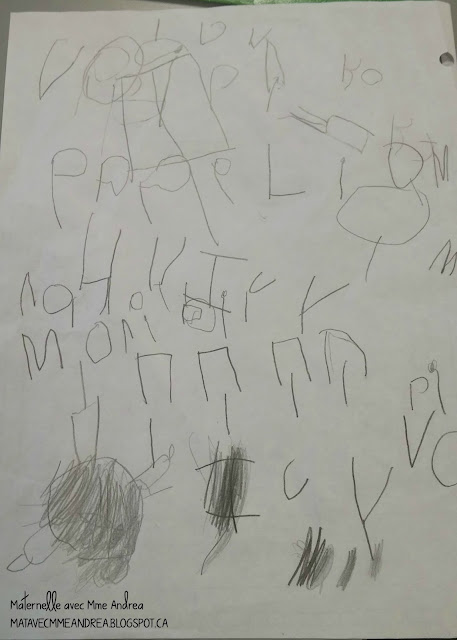
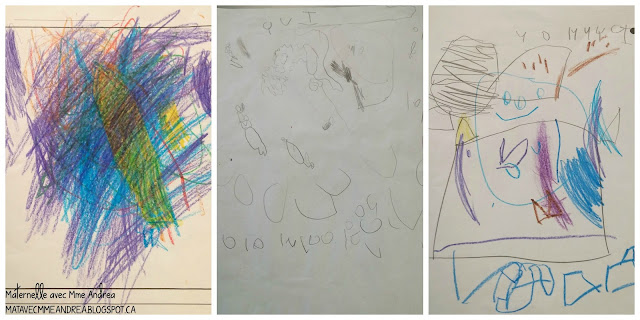



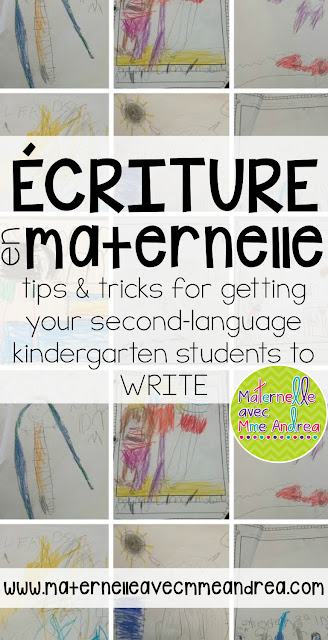



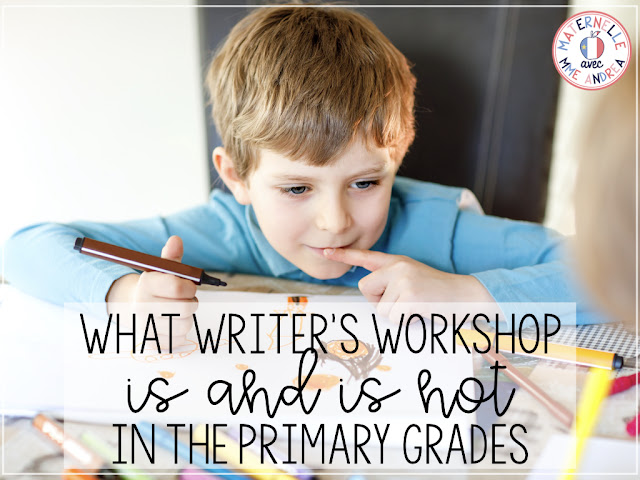
Great post.. I love seeing the progress. N'est-ce pas le meilleur cadeau de voir leur cheminement.. et seulement depuis un mois d'école!!
Merci!!! Je suis si fière :) Ils travaillent si fort!